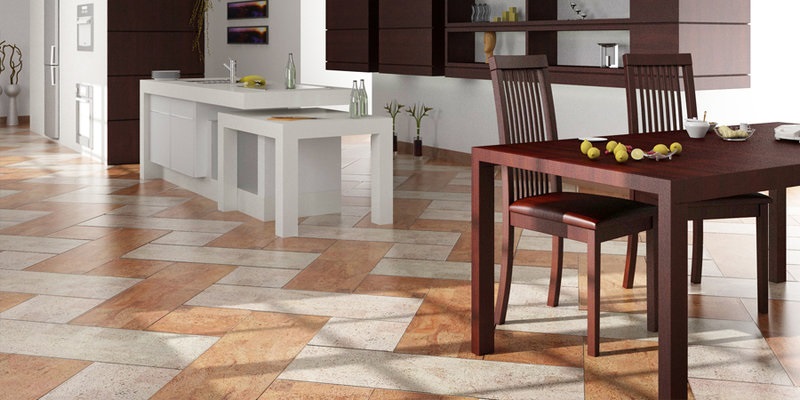Choosing a kitchen floor covering for the uninformed can be a daunting task. It is more important to give preference not so much to beauty as to practicality. And if possible, combine these two parameters. We invite you to deal with the flooring for the kitchen. Ideal floors in this room should be moisture resistant, easy to clean from household and food contaminants (fruit juices, wine, fat, etc.), have a durable surface, be decorative and fit into the overall design of the apartment (house). Many modern floor coverings meet these parameters in one way or another. Let’s pay attention to the most suitable options, as well as analyze their advantages and disadvantages during operation. Then you can decide for yourself which flooring is best for your kitch
Linoleum – a coating you can trust. Perhaps most often, the floor in kitchens is covered with linoleum flooring. This material is resistant to abrasion, is not afraid of moisture and hot steam, it is easy to clean, it is unlikely that a trace will remain on it after a heavy object falls. Linoleum is characterized by a low price, as well as a straightforward installation method that you can master yourself. In addition, linoleum, thanks to its huge assortment, allows for a variety of design ideas. It can be either a plain floor covering or an imitation of various more expensive materials: tiles, parquet, stone, metal.

The disadvantage of linoleum can be attributed to the formation of dents in the location of heavy furniture (refrigerator, cabinets, etc.). However, if furniture is installed in your kitchen “for centuries” and you are not going to move it, then you should not worry about the presence of dents – you will only learn about their existence when replacing the floor covering.
Ceramic tiles – the apotheosis of practicality Ceramic tiles have a durable surface that is characterized by a long-lasting color, is not subject to abrasion and does not interact with household chemicals. The tile flooring will not react to excess moisture or even flooding by neighbors. Modern tiles are very decorative and allow you to decorate your kitchen floor space in a variety of styles. Recently, tiles have become very fashionable, copying various “noble” materials: valuable wood, natural leather, precious metals, marble or other expensive stone. For the kitchen, it is better to choose tiles with a matte or even embossed surface that can save you from falling, for example, if you spill liquid on the floor.
Unfortunately, along with the advantages, tiled flooring has disadvantages. If a heavy object, especially metal, falls on the tile, there is a high probability that a crack will remain on the ceramic surface. In this case, to restore the decorative effect of the floor, the broken tiles will have to be replaced. Another disadvantage of tiles is the cold surface, which is a controversial pleasure to walk on barefoot, especially in winter. This problem can be solved by laying a rug on the tiles, or by installing a warm floor system under the ceramic surface.
Wooden floors – a symbol of nobility In the kitchen, a wooden floor speaks volumes about the good taste and well-being of its owner. Most often, we associate such a floor with parquet, but besides it there is one more fashionable material nowadays – wooden tiles, made in the form of tiles of various shapes and sizes.
When choosing flooring made of wood, you should give preference to hardwoods – they are more durable and durable. If you come across a parquet (tile) made of thermowood, take it without hesitation. Aged at high temperatures, wood is freed from all its shortcomings. It does not absorb, but repels water, does not shrink and does not swell, does not warp. At any temperature and any humidity in the kitchen, the thermowood parquet will not lose its appearance and properties.
Laminate – parquet from fiberboard (chipboard) Laminate is often used for kitchen flooring as a natural but cheaper substitute for parquet. The basis of the laminate is made of chipboard or fiberboard, on top of which paper with the desired pattern is glued. Usually, this pattern imitates wood and of any species, including valuable and exotic ones. Some manufacturers try to be original and produce a laminate that is almost indistinguishable in appearance from ceramics, marble, granite, slate, etc. The strengths of the laminate include a warm surface, ease of maintenance, and easy installation. Laminate could be one of the best floor coverings for the kitchen, if not for one “but”: it is afraid of moisture, and in the kitchen humidity is very often increased. If liquid is spilled on the floor, it should be wiped up immediately. If neighbors flood you and the puddles stand on the laminate for some time, the coating will be hopelessly damaged. The chipboard will swell and it will not be possible to restore the surface.

